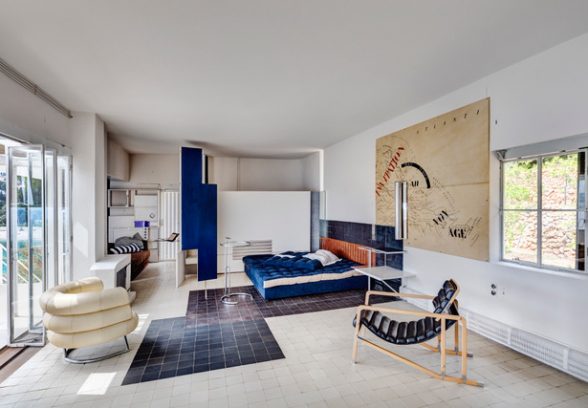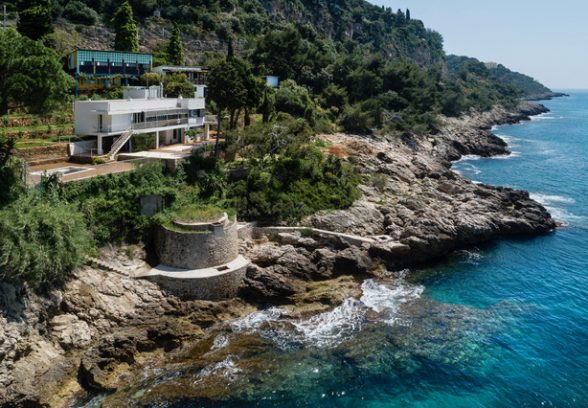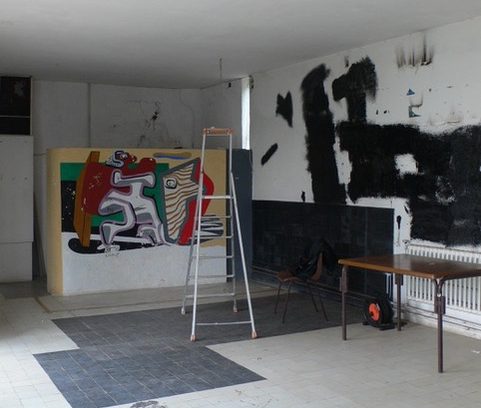This website uses cookies
This website uses cookies to enable it to function properly and to analyse how the website is used. Please click 'Close' to accept and continue using the website.





September 2018 - E-1027, Roquebrune-Cap-Martin, France
by Tim Benton
In 1926 Eileen Gray bought a plot on the Côte d’Azur, squeezed between a railway line and the rocky coastline with a beautiful view over the Bay of Monaco. Here she designed and built, with the help of her lover Jean Badovici, a villa that was both a fine example of modernist architecture and a criticism of aspects of functionalism. She called this house ‘E-1027’, embracing the initials of Badovici (10th and 2d letters of the alphabet) with her own. Into this design she poured her ingenuity as a designer, developed during ten years of success as an Art Deco ‘ensemblier’, or interior decorator, in Paris. It has become an iconic house, whose name is known as much for the furniture Gray designed as for the building itself.
The modernist villa is a large rectangular concrete box raised on pilotis under a flat roof with floor-to-ceiling windows. It has an open and flexible plan with movable partitions and space-saving, built-in furniture. Rooms open onto a balcony with tubular-steel rails. The main level of the house comprises a large open living room, kitchen, a study/bedroom and a bath, while a guest room and staff accommodation occupy the lower level. A spiral staircase links the spaces and leads to a roof-top garden with a sunbathing area and outdoor kitchen. Although the furniture was so integral to the original scheme, much of it was subsequently sold. Important pieces retained in the house include an elegant chiffonier in the bedroom that creates a screen for the wash basin, the dining table with a built-in electric light and cork top, and, at the back of the dining alcove, an ingenious foldable table that transforms the corridor into a beautiful bar. Perhaps the most iconic object is the Non Conformist chair. Gray noticed that most people sit to one side in a chair and tend to turn to look over the other side. She therefore designed it with one armrest curved and upholstered and the other as a simple slanted chrome steel bar.
After Gray’s death, E-1027 had been allowed to fall into disrepair. Restoration has been ongoing since 2006 and the house has been open to the public since 2015. The main funding for the restoration of E-1027 has come from the Association Cap Moderne, the DRAC (Directions régionales des affaires culturelles), the Conservatoire du Littoral and the Region. However, the remaining challenge is the recreation of the missing fixed and free-standing furnishings that they are mostly unable to finance.
Reconstructing furniture from scratch is an issue often debated in heritage circles. In this case, the importance and uniqueness of this work by one of Europe’s greatest designers convinced the Association Cap Moderne to attempt to re-present the house as much as possible exactly as it was in 1929, when it was published extensively in a special issue of Badovici’s journal L’Architecture Vivante. The approach has been to reproduce as closely as possible the original pieces using the same materials and methods. If the right pattern of glass cannot be found, new panes will be cut with a wheel to match precisely the original texture, for example. Textiles have been made by hand as they were originally, even though the fragility of the pieces creates issues for a house that must be visited to survive. In 2016 the bathroom was restored, as well as the ‘toilette complète’, the shower room at the end of the living room; its curved plywood wall and celluloid screen have been reintroduced. Since 2017 the remaining fixed furniture on the upper ground floor and free-standing pieces, including the large folding screen and the gramophone trolley, have been reconstructed. The original circulation of the garden has also been reinstated by replanting the lemon trees and removing a huge eucalyptus and a bamboo screen.
Heritage is not only a question of bricks and mortar, or in this case of reinforced concrete and nickelled steel. Gray expert Renaud Barrès spent four years on the site, under contract from the Roquebrune commune, meticulously documenting all the remaining elements in the house, as well as interviewing witnesses, acquiring documents and measuring surviving pieces of furniture in public and private collections. Our Association is concerned to record not only the tangible, but also the intangible, heritage of the site since the 1930s, capturing the memories and stories of neighbours and famous and not-so-famous visitors. Although so much has been achieved, we are now desperately in need of funds to complete the interiors. The Association Cap Moderne is therefore launching a Crowdfunding campaign to raise £50,000 – eligible for match funding from the French state – to refurnish the dining alcove and kitchen.
The realisation that Eileen Gray is one of Ireland’s finest creative artists is growing, and she is an attractive heroine. Androgynous, bisexual and entrepreneurial, she lived an extraordinary life. We hope to preserve both her memory and her wonderful designs through our continued work at E-1027.
Tim Benton
Tim Benton has been selected as the guest lecturer on the forthcoming Iconic Houses tour, from 9-16 October (Oslo, Cologne, Rotterdam, Prague and Brno), where he will talk about the restoration of E-1027.
To find out more about the restoration and help restore this iconic modernist house visit the E-1027 crowdfunding site which will be live shortly.
Watch a video about E 1027
A C20 Society tour to view E-1027 is being planned.
Look for past Buildings of the Month by entering the name of an individual building or architect or browsing the drop down list.

Become a C20 member today and help save our modern design heritage.